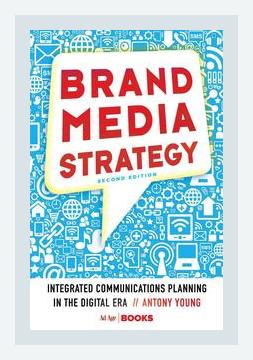Marketing and SalesAdvertisingBrand Management
Introduction
Antony Young’s “Brand Media Strategy: Integrated Communications Planning in the Digital Era” discusses how to navigate the complexities of brand communication in an era dominated by digital media. Focusing on the integration of traditional and digital platforms, Young provides actionable insights and strategies for media planners and brand managers to effectively engage their target audiences.
Chapter 1: The New Media Paradigm
Young begins by detailing the shift from traditional to digital media, emphasizing the rise of the Internet, social media, and mobile technology. This new paradigm has blurred the lines between consumers and brands, making two-way communication a necessity.
Actionable Takeaway:
- Adapt to Multi-channel Engagement: Brands should ensure their messaging is consistent across various platforms. By using analytics tools (e.g., Google Analytics), marketers can track and measure the effectiveness of their campaigns across different channels.
Chapter 2: The Importance of Integration
Integration is at the core of Young’s thesis. He argues that brands must harmonize their traditional and digital media efforts to create a unified brand message.
Example:
- The example of Nike integrating their “Just Do It” campaign across billboards, TV ads, and social media, ensuring that the message resonated regardless of the medium.
Actionable Takeaway:
- Create Unified Campaigns: Develop a master brand narrative that is adaptable to different media. Tools like HubSpot can help manage and synchronize campaigns across multiple platforms.
Chapter 3: Understanding the Consumer Journey
Young stresses the importance of understanding the consumer journey, noting that different stages (awareness, consideration, purchase, and loyalty) require different media strategies.
Example:
- The automotive industry often uses TV commercials for awareness, social proof on YouTube for consideration, special offers on the website for purchase, and email newsletters for loyalty.
Actionable Takeaway:
- Map Out Consumer Touchpoints: Use customer journey mapping tools (e.g., UXPressia) to identify and optimize each touchpoint where consumers interact with the brand.
Chapter 4: The Role of Data and Analytics
Young emphasizes the transformative power of data and analytics in personalizing and optimizing media strategies. He underscores the necessity of both quantitative and qualitative data.
Example:
- He cites Netflix’s use of data analytics to recommend shows to its users, enhancing user engagement and satisfaction.
Actionable Takeaway:
- Leverage Data Analytics: Invest in analytics software (e.g., Adobe Analytics) to gain insights into consumer behavior and tailor media strategies accordingly.
Chapter 5: Content is King
Young delves into the significance of quality content, stating that engaging stories and valuable information are critical for capturing consumer attention.
Example:
- Red Bull’s content marketing efforts include extreme sports videos and the Stratos space jump, which resonate with their brand ethos and target audience.
Actionable Takeaway:
- Invest in High-Quality Content: Allocate resources to content creation, and use tools like BuzzSumo to identify trending topics and develop content that aligns with your brand.
Chapter 6: The Power of Social Media
Social media’s role in brand media strategy cannot be overstated. Young explains how platforms like Facebook, Twitter, and Instagram can be leveraged to build and maintain relationships with consumers.
Example:
- Dove’s “Real Beauty” campaign used social media to engage with their audience through meaningful conversations about beauty standards.
Actionable Takeaway:
- Engage Authentically on Social Media: Develop a social media plan that includes interactive content (polls, Q&A sessions), and use tools like Hootsuite to manage and track social media efforts.
Chapter 7: Paid Media in the Digital Era
Young argues that while earned and owned media are crucial, paid media still holds significant value, especially in amplifying messages and reaching broader audiences.
Example:
- Coca-Cola’s strategic use of sponsored content and targeted ads during major events like the Super Bowl to maximize reach and engagement.
Actionable Takeaway:
- Strategically Use Paid Media: Employ programmatic advertising platforms (e.g., Google Ads, Facebook Ads) to target specific demographics and measure ROI.
Chapter 8: The Importance of Mobile
Mobile’s prominence as a primary medium for consumer interaction means brands need to prioritize mobile-friendly content and advertisements.
Example:
- Starbucks’ mobile app, which combines loyalty rewards, payment options, and customized offers, demonstrates the effectiveness of mobile integration.
Actionable Takeaway:
- Optimize for Mobile: Ensure your website and advertisements are mobile-friendly by using responsive design principles and testing on various devices.
Chapter 9: Measurement and ROI
Young underscores the importance of measuring the effectiveness of media strategies to gauge ROI and make data-driven decisions.
Example:
- Procter & Gamble’s use of multi-touch attribution to measure the effectiveness of their diverse advertising strategy across different media.
Actionable Takeaway:
- Implement Robust Measurement Systems: Invest in comprehensive measurement tools (e.g., Nielsen, Comscore) to track the impact of advertising across various channels and improve future campaigns.
Chapter 10: Future Trends
Young concludes by discussing emerging trends such as augmented reality, virtual reality, and artificial intelligence. These technologies will further revolutionize how brands interact with consumers.
Example:
- IKEA’s AR app that allows users to visualize furniture in their homes before making a purchase, enhancing the consumer shopping experience.
Actionable Takeaway:
- Stay Ahead of Emerging Trends: Continuously monitor industry developments and be prepared to integrate new technologies into your brand’s media strategy. Exploring partnerships with tech firms can provide an early advantage.
Conclusion
“Brand Media Strategy: Integrated Communications Planning in the Digital Era” by Antony Young offers comprehensive guidance on navigating the modern media landscape. By understanding and leveraging integrated communication strategies, brands can more effectively connect with their target audiences. The actionable takeaways provided in each chapter equip marketers and brand managers with practical steps to implement Young’s expert advice, ensuring their media plans are both current and impactful.
